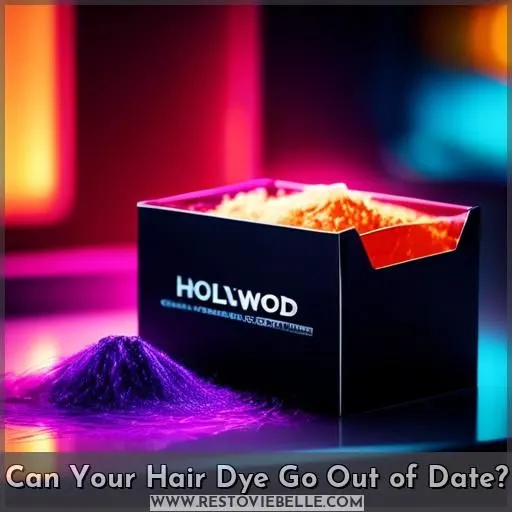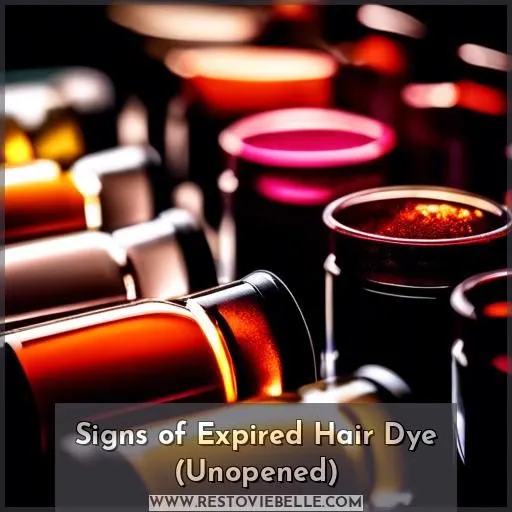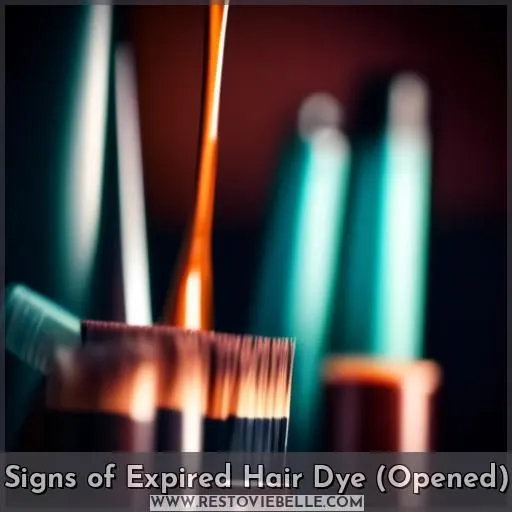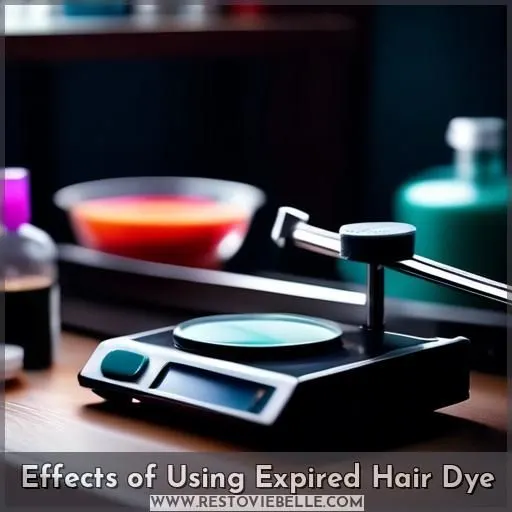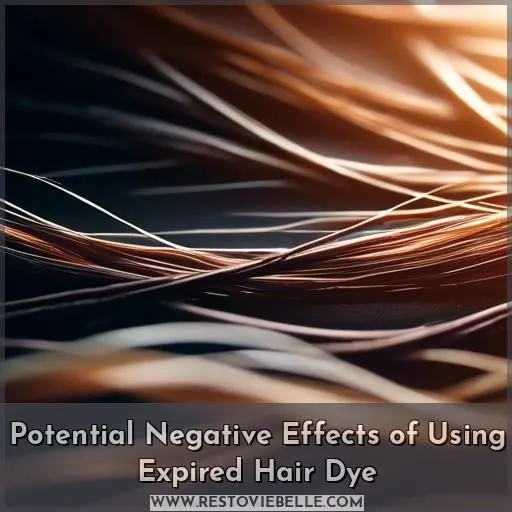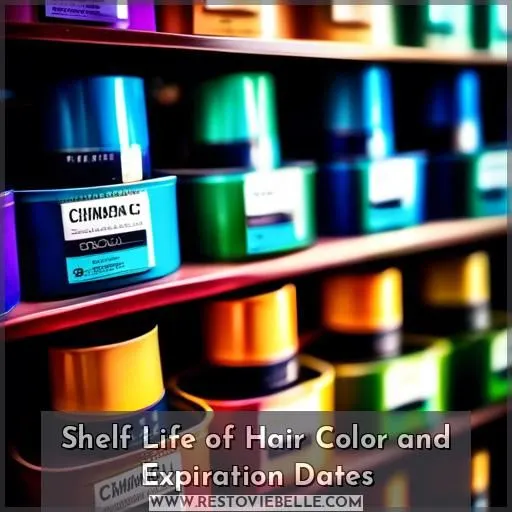This site is supported by our readers. We may earn a commission, at no cost to you, if you purchase through links.
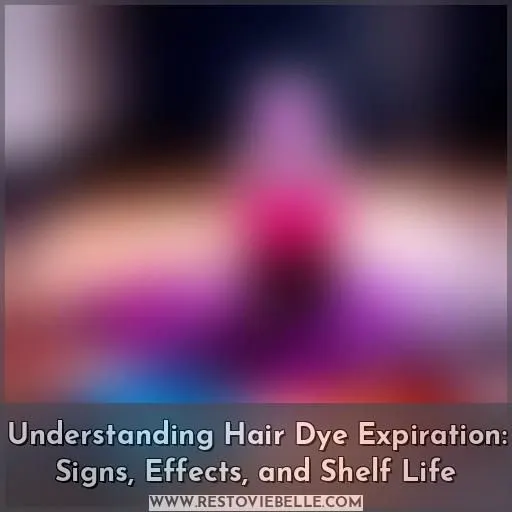
Yes, hair dye can go out of date. Unopened hair dye can last up to three years, but it may not produce the intended results after this period. Signs of expired unopened hair dye include a pungent or atypical aroma, peculiar hue, streaks or separation in the liquid, and cracks or leakage in the container.
Opened hair dye can oxidize if not used immediately, leading to changes in consistency and color. Using expired hair dye can result in color variation, allergic reactions, scalp irritation, hair damage, and greenish discoloration for light blonde, white, or gray hair.
Table Of Contents
- Key Takeaways
- Can Hair Dye Go Out of Date?
- Can Your Hair Dye Go Out of Date?
- Signs of Expired Hair Dye (Unopened)
- Signs of Expired Hair Dye (Opened)
- Effects of Using Expired Hair Dye
- Potential Negative Effects of Using Expired Hair Dye
- Shelf Life of Hair Color and Expiration Dates
- Frequently Asked Questions (FAQs)
- Conclusion
Key Takeaways
- Unopened hair dye can last for up to three years, but it may not produce the intended results after this period.
- Opened hair dye can oxidize if not used immediately, leading to changes in consistency and color.
- Using expired hair dye can result in color variation, allergic reactions, scalp irritation, hair damage, and greenish discoloration for light blonde, white, or gray hair.
- To determine if your opened hair dye has expired, look for signs such as oxidized chemicals, natural products degrading rapidly, exposure to sunlight, air, moisture, heat, or humidity, and allergic reactions.
Can Hair Dye Go Out of Date?
Yes, hair dye can go out of date. The shelf life of hair dye varies depending on whether it is opened or unopened. On average, an opened hair dye lasts for 1-2 years, while an unopened hair dye can last up to 3 years. However, hair dye can expire more quickly if it is exposed to external factors such as direct sunlight, heat, humidity, or if it is mixed with other chemicals. Expired hair dye may not work effectively, may cause unwanted side effects to your hair or scalp, or may lead to uneven coloring results.
Can Your Hair Dye Go Out of Date?
Unopened hair dye can last up to 3 years. After that, it may not produce the intended results. Chemical reactions can cause green discoloration, especially for light blonde, white, or gray hair.
If you open a hair dye box and don’t use it right away, the chemicals can oxidize, leading to a darker color result or uneven color.
If you suspect your hair dye has expired, check for signs like a sour smell, unusual color, or separated liquid.
Signs of Expired Hair Dye (Unopened)
Regarding hair dye, the inquiry of its potential expiration raises concerns. Although hair dyes typically maintain their potency for 2-3 years, their overall integrity hinges on variables such as storage circumstances and the inclusion of ammonia and peroxide. To ascertain whether your hair dye has surpassed its prime, several indicators merit attention, particularly for unopened products.
Initially, if the dye exudes a pungent, acrid, or atypical aroma, it may have expired. Moreover, if the hue seems peculiar or the liquid exhibits streaks or separation, these manifestations also signal expired hair dye. If the container presents cracks or leakage, it unequivocally suggests the dye’s expiration.
It bears noting that unopened hair dye defies expiration, but aged hair dye may not yield optimal results. No scientific evidence substantiates the notion that old hair dye poses risks, but it may not produce the anticipated effects.
Signs of Expired Hair Dye (Opened)
When it comes to hair dye, the shelf life can vary depending on whether the dye is opened or unopened. For an unopened hair dye, the manufacturer typically indicates a shelf life of about 3 years. However, there are no expiration dates listed on most hair dye boxes, so it’s imperative to pay attention to the signs that your hair dye may have expired.
If you’ve opened your hair dye, it’s imperative to use it within a certain time frame. Manufacturers recommend using opened, unmixed containers within 6 weeks. Over time, oxidized chemicals can lead to a darker color result, and natural products may degrade more rapidly after opening. Exposure to sunlight, air, moisture, heat, or humidity can also affect the dye’s quality.
To determine if your opened hair dye has expired, look for signs such as:
- Oxidized chemicals: The dye may have a different consistency or texture, or it might’ve a darker color result.
- Natural products degrade rapidly: If you’re using a natural hair coloring product, it may not last as long as a traditional hair dye.
- Exposure to sunlight, air, moisture, heat, or humidity: These factors can cause the dye to degrade more quickly.
- Allergic reactions: If the dye is imbalanced due to the expiry date, it may cause allergic reactions.
- Burns: Expired hair dye may cause chemical burns on the scalp.
If you notice any of these signs, it’s best to discard the dye and purchase a fresh one. Remember, using expired hair dye may not produce the intended results and could potentially cause negative effects, such as greenish discoloration for light blonde, white, or gray hair and allergic reactions.
To avoid using expired hair dye, follow these tips:
- Check the expiration date on the hair dye package, if available.
- Inspect the dye for signs of expiration, such as a strange smell, product separation, or an overly bright color.
- Store hair dye in a cool, dry place away from direct sunlight, heat, and humidity.
- Discard dye if it has been frozen or if storage conditions have been compromised.
- Use natural hair coloring products, such as henna or organic hair dyes, to avoid chemicals.
Effects of Using Expired Hair Dye
When you reach for that box of hair dye, you might not think twice about the date. But beware, using expired dye can be like opening Pandora’s box of color variation. You’re aiming for chestnut but might end up with a shade closer to midnight mystery.
It’s not just about the hue; expired products can lead to a tango of allergic reactions. Oxidation effects are the culprits here, turning your dyeing experience into a chemistry experiment gone wrong. And let’s not forget the scalp irritation that can crash the party uninvited.
So, before you color, remember that old dye can come with negative consequences that are more than skin deep.
Potential Negative Effects of Using Expired Hair Dye
Using expired hair dye can lead to several potential negative effects, including:
- Allergic reactions: Expired hair dye may contain imbalanced chemicals, which can cause allergic reactions in some individuals.
- Skin irritation: Expired hair dye can irritate the scalp and cause redness, itching, or even blisters.
- Scalp damage: Prolonged use of expired hair dye can damage the scalp, leading to issues like dandruff or hair loss.
- Hair damage: Expired hair dye can cause hair to become dry, dull, and brittle.
- Greenish discoloration: This is a common concern for people with light blonde, white, or gray hair, as expired hair dye may turn hair green due to oxidation on hard metals like copper.
It’s essential to be aware of these potential negative effects and to check the signs of expired hair dye before use. If you suspect your hair dye has expired, it’s best to discard it and invest in a fresh product.
Shelf Life of Hair Color and Expiration Dates
In the realm of hair dye, comprehending its shelf life and expiration is essential for preserving its efficacy and safety. While manufacturers suggest a shelf life of roughly 3 years, hair dye boxes frequently omit expiration dates. Notwithstanding, unopened hair dye doesn’t lapse, but aged dye may not perform adequately. To ascertain the freshness of your hair dye, inspect for indicators such as a pungent odor, peculiar color, discolored or separated liquid, a fractured or leaking bottle, or oxidized chemicals if the product has been opened.
Manufacturers advise utilizing opened, unmixed containers within 6 weeks to prevent oxidation, which can result in a shade darker than expected, inconsistent color outcomes, or even potential adverse effects like greenish discoloration, allergic reactions, burns, or intensified chemical effects. Shelf life is also affected by storage conditions, with products enduring longer when kept away from heat, moisture, sunlight, and in the original container.
To safeguard product freshness, some companies proactively provide expiration dates or batch codes for transparency. Batch codes can be used to track product age, and websites like Check Fresh can assist in determining product age using these codes. Furthermore, adhering to storage guidelines and safety precautions, such as perusing and following instructions, conducting a patch test, donning gloves, and avoiding contact with eyes, can minimize potential hazards associated with employing expired hair dye.
Frequently Asked Questions (FAQs)
How does hair dye affect natural hair texture?
Hair dye can impact natural hair texture in various ways, contingent on the hair type and the dyeing procedure. For instance, curly hair can become more pronounced and less frizzy after dyeing, while fine and straight hair may become more absorbent and susceptible to shedding if over-processed. Blonde hair**, which often requires bleaching prior to dyeing, can cause damage and lead to a reduction in elasticity and curl pattern.
When dyeing natural hair, it’s crucial to account for the hair’s texture and take appropriate precautions to minimize damage. This includes utilizing cream-based hair dyes for coarse hair, eschewing over-processing, and guaranteeing proper application techniques to preserve the curl pattern. Additionally, it’s recommended to consult with a professional hairstylist or colorist to guarantee the best results and minimize potential damage.
Can expired hair dye cause long-term scalp damage?
Using expired hair dye may cause your hair to turn into an undesirable color, such as green for light blonde, white, or gray hair. It can also lead to allergic reactions and chemical burns. While there’s no evidence that old hair dye is dangerous to use, it may not work effectively and can cause uneven color results.
If you suspect your hair dye is expired, check for signs such as a foul smell, unusual color, or separation. It’s recommended to use opened hair dye within 6 weeks and to store it away from heat, humidity, and direct sunlight.
Are there eco-friendly alternatives to traditional hair dyes?
Yes, there are eco-friendly alternatives to traditional hair dyes. Many of these alternatives are made from natural ingredients, such as henna, indigo, and plant-based dyes. These dyes are often free from harsh chemicals like ammonia, petrochemicals, sulfates, phthalates, parabens, and P-phenylenediamine (PPD).
While these dyes may not be as strong as traditional dyes, they can still provide color and are generally considered safer for both the user and the environment.
How do professional salon dyes compare with at-home kits?
Professional salon dyes and at-home kits have their own advantages and disadvantages. Salon dyes are typically of higher quality, with better ingredients and customized color formulations that can deliver more vibrant and long-lasting results. Salon dyes are also safer and gentler on your hair, as they’re applied by experienced professionals who can guarantee a precise application and avoid damaging your hair. However, salon dyes can be more expensive and may require scheduling appointments, which can be inconvenient for some people.
On the other hand, at-home kits are more affordable and convenient, as you can do them yourself anytime you want. They’re widely available at stores and offer a variety of color options. However, at-home dyes may contain harsher chemicals and lack the protective ingredients found in salon dyes, which can lead to damage, breakage, or even hair loss. The results may also be unpredictable, and it can be difficult to achieve a precise color match without professional assistance.
What are the best practices for conducting a patch test?
To conduct a patch test for hair dye, follow these steps:
- Choose a suitable area on your body where the color can sit for a while, typically behind your ear or your inner elbow.
- Make sure your skin is fresh and clean, so there’s no risk of any contaminants affecting your test.
- Apply a small amount of hair color mixture behind your ear using a cotton bud or cotton wool pad wrapped around the pointed tip of the color brush.
- Leave it on for 48 hours before washing off.
- If you experience any signs of an allergic reaction, such as itching, redness, swelling, or stinging, wash the color off immediately and don’t use the product.
If your skin patch test causes no negative reactions, you’re all clear to use your hair dye. It’s vital to perform a patch test before using hair dye, even if you’ve used it before, as skin can develop new allergies at any stage of your life.
Conclusion
Just like a fine wine, hair dye too has a shelf life. It’s essential to comprehend the signs, effects, and shelf life of hair dye to avert potential problems. Outdated hair dye can result in color variation, allergic reactions, scalp irritation, hair damage, and even greenish discoloration for light blonde, white, or gray hair.
Before you reach for that old bottle, bear in mind that hair dye can indeed expire. Expired hair dye can cause a range of issues, including:
- Color variation: The color may turn out differently than expected, or it may not take evenly.
- Allergic reactions: Expired dye can trigger skin irritation or allergic reactions.
- Scalp irritation: The chemicals in expired dye can cause irritation and discomfort on the scalp.
- Hair damage: Outdated dye can be harsh on the hair, leading to dryness, brittleness, and breakage.
- Greenish discoloration: For light blonde, white, or gray hair, expired dye can result in an undesirable greenish tint.
